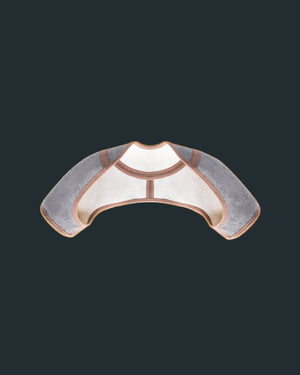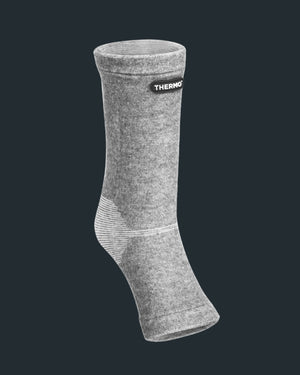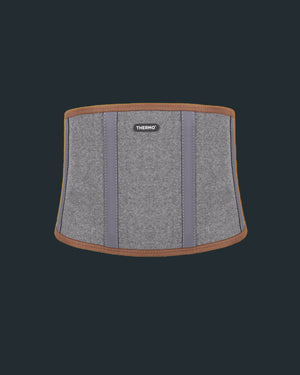Posterior ankle pain can be a debilitating issue, affecting mobility and daily life, making it a major health concern. This discomfort arises from a range of cause...
Posterior ankle pain can be a debilitating issue, affecting mobility and daily life, making it a major health concern. This discomfort arises from a range of causes, prompting immediate attention.
The ankle's intricate design leaves it susceptible to injury and strain. Neglecting symptoms can escalate to chronic conditions, which can impair daily activities and put you in a lot of pain.
However, knowing how to address this issue early is key to recovery to keep a healthy, active lifestyle and prevent future complications.
What Is Posterior Ankle Pain?
Posterior ankle pain is discomfort or aching sensation experienced at the back of the ankle, just above the heel where the Achilles tendon connects to the heel bone.
This can feel like a dull, constant ache to a sharp, pinpoint discomfort that may intensify during activities that involve pushing off the foot or when stretching the foot upwards. It can also manifest as a throbbing sensation at rest, particularly after long periods of activity or standing.
Posterior ankle pain can create a sensation of tightness that restricts movement, making it difficult to perform motions such as walking, running, or jumping. It can also lead to compensatory movements that alter your gait, potentially causing additional strain to other parts of the foot, ankle, or even the leg.
Common Causes of Posterior Ankle Pain
1. Posterior Ankle Impingement Syndrome
Also called bony posterior ankle impingement, this occurs when soft tissues or bony structures at the back of the ankle are compressed. It's common in athletes who engage in repetitive plantar flexion movements.
Posterior impingement presents as a sharp, pinching sensation in the back of the ankle, especially during activities that involve pointing the toes downward.
2. Tendon Disorders
Tendon disorders, such as Achilles tendonitis or flexor hallucis longus tendinopathy, can lead to posterior ankle pain, often due to overuse or improper footwear.
Check out how to support your Achilles tendon better using these gears.
3. Arthritis and Joint Issues
Osteoarthritis or inflammatory arthritis like rheumatoid arthritis can affect the ankle joint, leading to pain and stiffness at the back of the ankle.
4. Fractures and Trauma
A direct impact or awkward fall can cause fractures or other traumatic injuries to the ankle, resulting in acute posterior pain.
Symptoms of Posterior Ankle Joint Pain
- Sharp Pain or Throbbing in the Back of the Ankle: This can occur during movement or at rest, sometimes described as a stabbing sensation that may become a constant, dull throb.
- Swelling and Tenderness: Inflammation in the affected area can lead to visible swelling, tenderness to the touch, and a sensation of warmth in the posterior ankle region.
- Stiffness After Periods of Inactivity: You may notice stiffness that tends to improve with gentle movement but can be particularly pronounced upon waking or after sitting for extended periods.
- Reduced Range of Motion: Pain in the posterior part of the ankle can hinder your ability to flex the foot upwards or downwards, often impeding your gait and making it challenging to perform activities that require pushing off the toes.
- Instability When Bearing Weight: The affected ankle may feel weak or unsteady, especially when walking on uneven surfaces or when participating in activities that require quick changes in direction.
- Crepitus: This refers to a crackling or popping sensation or sound when the ankle joint is moved, indicating potential joint or soft tissue involvement.
Step-by-Step Guide to Diagnosing Posterior Ankle Pain
Step 1. Physical Examination
- Visit your healthcare provider to have your ankle examined.
- Discuss your symptoms such as tenderness, swelling, and any range of motion limitations.
- Undergo a hands-on assessment where the doctor will palpate the affected area and test the ankle's movement.
Step 2. Imaging Tests
- Obtain an X-ray to check for bone fractures and signs of arthritis.
- Schedule a Magnetic Resonance Imaging (MRI) or Ultrasound, if recommended, for a more detailed view of soft tissues like tendons and ligaments.
Step 3. Advanced Diagnostic Procedures
- Consider further testing such as a bone scan or CT scan if initial imaging does not conclusively determine the cause of your pain.
- Follow your doctor's guidance to complete these advanced imaging tests, which provide a comprehensive overview of the ankle structure.
Step 4: Analysis and Plan
- Review results with your healthcare provider to analyze the findings from the examinations and tests.
- Develop a treatment plan based on the diagnosis to address your specific condition and symptoms.
Treatment Options for Posterior Ankle Pain
Non-Surgical Treatment Options
Rest and Ice
Avoid activities that exacerbate the pain to allow the ankle to heal. You should also refrain from repetitive motion or weight-bearing on the affected ankle. Apply ice to the affected area in increments of 15-20 minutes several times a day to reduce swelling and provide pain relief.
Physical Therapy and Exercises
Engage in a supervised therapy program tailored to your condition, focusing on exercises that enhance strength and remedy ankle instability. Also, perform specific movements and stretches recommended by your therapist to improve the ankle's range of motion and support recovery.
Medications and Injections
Utilize over-the-counter or prescribed nonsteroidal anti-inflammatory drugs to decrease inflammation and manage pain. You can also receive injections to target inflammation directly in the ankle joint, providing more significant relief.
Alternative Therapies
Try acupuncture, a traditional Chinese medicine approach that may help in reducing pain and promoting healing by targeting specific points on the body. Also, consider massage therapy to relax the muscles around the ankle, improve circulation, and aid in the reduction of pain and stiffness.
Surgical Intervention and Procedures
Types of Surgical Options
- Arthroscopic Debridement: This less invasive surgical technique involves the insertion of a small camera called an arthroscope into the ankle joint. Surgeons use miniature instruments to remove inflamed tissue or debris that may be causing pain, improving joint function with minimal recovery time.
- Osteophyte Removal: When bone spurs (osteophytes) are present and contribute to posterior ankle pain, they can be surgically removed to alleviate impingement and restore range of motion.
- Reconstructive Surgery: In cases where there are significant structural abnormalities, such as misalignments or severe joint damage, reconstructive procedures like tendon repair, ligament reconstruction, or realignment osteotomies may be performed to correct the anatomy and restore proper joint mechanics.
Rehabilitation and Preventing Future Pain
Rehabilitation plays a vital role in regaining strength and preventing future discomfort. A regimen of targeted exercises is imperative to fortify the muscles surrounding the ankle and augment flexibility.
To mitigate the risk of recurring pain, adopting preventative measures is equally important. This includes selecting appropriate footwear that offers support and cushioning, steering clear of activities that overtax the ankle, and heeding the body's signals to rest when needed.
Conclusion
Addressing posterior ankle pain effectively involves a multifaceted approach, encompassing accurate diagnosis, tailored treatment, and diligent rehabilitation.
By understanding the potential causes and symptoms and seeking appropriate medical care, you can navigate the path to relief and recovery.
Wear quality ankle support gear and don't hesitate to consult a healthcare professional for personalized advice and treatment options.
Sources:
Posterior Ankle Impingement | Physio-Pedia






